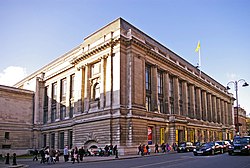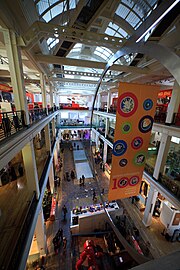Difference between revisions of "Science Museum"
(Created page with "{{Infobox building |name=Science Museum |county=Middlesex |town=Kensington |picture=Science Museum, Exhibition Road, London SW7 - geograph.org.uk - 1125595.jpg |picture captio...") |
(→Power: The East Hall) |
||
| Line 47: | Line 47: | ||
===Power: The East Hall=== | ===Power: The East Hall=== | ||
| − | |||
The East Hall is the first area that most visitors see as they enter the building, stretching up through three floors. On the ground, the area is mostly filled with iconic steam engines of various sorts, including 'Old Bess', the oldest surviving James Watt beam engine, which together tell the story of the British industrial revolution. Close by is Stephenson's ''Rocket''. | The East Hall is the first area that most visitors see as they enter the building, stretching up through three floors. On the ground, the area is mostly filled with iconic steam engines of various sorts, including 'Old Bess', the oldest surviving James Watt beam engine, which together tell the story of the British industrial revolution. Close by is Stephenson's ''Rocket''. | ||
Latest revision as of 15:59, 5 June 2019
| Science Museum | |
|
Middlesex | |
|---|---|
 The Science Museum | |
| Type: | Museum |
| Location | |
| Grid reference: | TQ26807920 |
| Location: | 51°29’51"N, 0°10’29"W |
| Town: | Kensington |
| History | |
| Address: | Exhibition Road SW |
| Built 1913-1928 | |
| Museum | |
| Information | |
| Website: | sciencemuseum.org.uk |
The Science Museum is a major museum on Exhibition Road in South Kensington, Middlesex. It was founded in 1857 and today is one of the city's major tourist attractions, attracting 3.3 million visitors annually.[1] The building itself is later, with work beginning in 1913.
The Science Museum is part of the 'Science Museum Group', along with the Museum of Science and Industry in Manchester, with which it merged in 2012.
Contents
Origin and history
A museum was founded in 1857 under Bennet Woodcroft from the collection of the Royal Society of Arts and surplus items from the Great Exhibition as part of the South Kensington Museum, together with what is now the Victoria and Albert Museum. It included a collection of machinery which became the Museum of Patents in 1858, and the Patent Office Museum in 1863. This collection contained many of the most famous exhibits of what is now the Science Museum.
In 1883, the contents of the Patent Office Museum were transferred to the South Kensington Museum. In 1885, the Science Collections were renamed the Science Museum and in 1893 a separate director was appointed.[2] The Art Collections were renamed the Art Museum, which eventually became the Victoria and Albert Museum.
When Queen Victoria laid the foundation stone for the new building for the Art Museum, she stipulated that the museum be renamed after herself and her Prince Albert, her late husband. This name, 'Victoria and Albert', initially applied to the whole museum, was ten years later, at the opening of he new building, confined to the Art Collectionst.[3] On 26 June 1909 the Science Museum, as an independent entity, came into existence.[3]
The Science Museum's present quarters, designed by Sir Richard Allison, were opened to the public in stages over the period 1919–28.[4] This building was known as the 'East Block'. Construction began in 1913 but was temporarily halted by First World War. As the name suggests it was intended to be the first building of a much larger project, which was never realized. However, the Museum buildings were expanded over the following years; a pioneering Children's Gallery with interactive exhibits opened in 1931,[3] the Centre Block was completed in 1961-3, the infill of the East Block and the construction of the Lower & Upper Wellcome Galleries in 1980, and the construction of the Wellcome Wing in 2000 result in the Museum now extending to Queen's Gate.
Collections
The Science Museum now holds a collection of over 300,000 items, including such famous items as Stephenson's Rocket, Puffing Billy (the oldest surviving steam locomotive), the first jet engine, a reconstruction of Francis Crick and James Watson's model of DNA, some of the earliest remaining steam engines (Including an example of a Newcomen steam engine, the world’s first steam engine), a working example of Charles Babbage's Difference engine, the first prototype of the 10,000-year Clock of the Long Now, and documentation of the first typewriter. It also contains hundreds of interactive exhibits. A recent addition is the IMAX 3D Cinema showing science and nature documentaries, most of them in 3-D, and the Wellcome Wing which focuses on digital technology. Entrance has been free since 1 December 2001.
The museum houses some of the many objects collected by Henry Wellcome around a medical theme. The fourth floor exhibit is called "Glimpses of Medical History", with reconstructions and dioramas of the history of practised medicine. The fifth floor gallery is called "Science and the Art of Medicine", with exhibits of medical instruments and practices from ancient days and from many countries. The collection is strong in clinical medicine, biosciences and public health. The museum is a member of the London Museums of Health & Medicine.
The Science Museum has a dedicated library, and until the 1960s was Britain's National Library for Science, Medicine and Technology. It holds runs of periodicals, early books and manuscripts, and is used by scholars worldwide. It was, for a number of years, run in conjunction with the Library of Imperial College, but in 2007 the Library was divided over two sites. Histories of science and biographies of scientists were kept at the Imperial College Library in London until February 2014 when the arrangement was terminated, the shelves were cleared and the books and journals shipped out, joining the rest of the collection, which includes original scientific works and archives, in Wroughton, Wiltshire.[5]
The Science Museum's medical collections have a global scope and coverage. Strengths include Clinical Medicine, Biosciences and Public Health. The new Wellcome Wing, with its focus on Bioscience, makes the Museum a leading world centre for the presentation of contemporary science to the public.
Some 170,000 items which are not on current display are stored at Blythe House in West Kensington. Blythe House also houses facilities including a conservation laboratory, a photographic studio, and a quarantine area where newly arrived items are examined.[6]
Galleries
The Science Museum is made up of a number of galleries, some of which are permanent, and some of which are temporary.
Power: The East Hall
The East Hall is the first area that most visitors see as they enter the building, stretching up through three floors. On the ground, the area is mostly filled with iconic steam engines of various sorts, including 'Old Bess', the oldest surviving James Watt beam engine, which together tell the story of the British industrial revolution. Close by is Stephenson's Rocket.
Also on display is a recreation of James Watt's garret workshop from his home, Heathfield Hall, using over 8,300 objects removed from the room, which was sealed after his 1819 death, when the hall was demolished in 1927.[7]
Exploring Space
Exploring Space is a historical gallery, filled with rockets and exhibits that tell the story of human space exploration and the benefits that space exploration has brought us (particularly in the world of telecommunications).
Making the Modern World
Making the Modern World is a relatively new gallery, in which some of the museum's most iconic objects, including Stephenson's Rocket, Watson and Crick's double helix, and an Apollo spacecraft, are imaginatively displayed along a timeline chronicling man's technological achievements.
Flight
Flight is another longstanding gallery, up towards the western end of the third floor. Contained in the gallery are several full sized aeroplanes and helicopters, including Alcock and Brown's transatlantic Vickers Vimy (1919), Spitfire and Hurricane fighters, as well as numerous aero-engines and a cross-section of a Boeing 747.
Launchpad
One of the most popular galleries in the museum is the interactive Launchpad gallery. Redesigned and reopened in November 2007, the new look gallery houses over 50 interactive exhibits illustrating many different concepts in physical science. The gallery is staffed by Explainers who are available to demonstrate how exhibits work, conduct live experiments and perform shows to schools and the visiting public. Launchpad has now closed,[8] the Science Museum are preparing a new Interactive gallery which opens in late 2016. The new gallery will be bigger than Launchpad and packed with state-of-the-art interactive exhibits.
Media Space
This gallery is a collaboration between the Science Museum and the National Science and Media Museum in Bradford, home of a photography collection of more than three million images.[9]
Information Age
The landmark gallery explores the six networks that have transformed global communications: The Cable, The Telephone Exchange, Broadcast, The Constellation, The Cell and The Web/[10]
It was opened on 24 October 2014 by the Queen, Elizabeth II, who sent her first tweet.[11] It replaced the former Shipping galleries, on the second floor, which closed on 15 May 2012. Their contents were 3D scanned and made available online.[12]
Engineer your Future
A gallery which opened in December 2014 that aims to inspire school children to go into careers in engineering, developed with a consortium of companies and the Royal Academy of Engineering.[13]
Projects
- Lates: adults only evenings with up to 30 events, from lectures to silent discos. Previous 'Lates' have seen conversations with the actress activist Lily Cole[14] and Biorevolutions with the Francis Crick Institute which attracted around 7000 people, mostly under the age of 35.[15]
- School visits
- Science Nights: described as "all-night extravaganza with a scientific twist", when to 380 children aged between 8 and 11, accompanied by adults, are invited to spend an evening performing fun "science based" activities and then spend the night sleeping in the museum galleries amongst the exhibits.
- The Dana Centre: opened in November 2003. It is an urban bar and café annexed to the museum.
- Temporary exhibitions
- Touring exhibitions
Outside links
| ("Wikimedia Commons" has material about Science Museum) |
- The Science Museum
- Albertopolis: Science Museum — architecture and history of the Science Museum
- The Science Museum Group
- Mapping the World's Science Museums - Nature Publishing Group
References
- ↑ "Big Ambitions Serious science: Annual Review 2013–14" (PDF). Sciencemuseum.org.uk. http://www.sciencemuseum.org.uk/about_us/smg/~/media/2B9657C82B22462DA0F4B8020C76CB60.pdf. Retrieved 2015-03-10.
- ↑ Science Museum
- ↑ 3.0 3.1 3.2 "Museum history". About us. London: Science Museum. http://www.sciencemuseum.org.uk/about-us/history. Retrieved 2016-06-24.
- ↑ Encyclopædia Britannica. "Science Museum (museum, London, United Kingdom) – Britannica Online Encyclopedia". Britannica.com. http://www.britannica.com/EBchecked/topic/528865/Science-Museum. Retrieved 2010-07-07.
- ↑ "Library and Archives – About us". Science Museum. 3 February 2010. http://www.sciencemuseum.org.uk/about_us/about_the_museum/science_library.aspx. Retrieved 10 June 2015.
- ↑ "Blythe House – About us – Science Museum London". http://www.sciencemuseum.org.uk/ingenioustours. Retrieved 21 September 2011.
- ↑ Watt's workshop - The Science Museum
- ↑ http://www.sciencemuseum.org.uk/visitmuseum/Plan_your_visit/exhibitions/launchpad.aspx
- ↑ "Media Space". Sciencemuseum.org.uk. http://www.sciencemuseum.org.uk/visitmuseum/media_space.aspx. Retrieved 10 March 2015.
- ↑ http://www.sciencemuseum.org.uk/visitmuseum/Plan_your_visit/exhibitions/information_age.aspx Science Museum website – Information Age Gallery
- ↑ "Her Majesty The Queen sends her first tweet to unveil the Information Age | Inside the Science Museum". Blog.sciencemuseum.org.uk. 24 October 2014. http://blog.sciencemuseum.org.uk/insight/2014/10/24/her-majesty-the-queen-sends-her-first-tweet-to-unveil-the-information-age/. Retrieved 10 March 2015.
- ↑ http://www.sciencemuseum.org.uk/about_us/press_and_media/press_releases/2013/07/Shipping_galleries_3D_scan.aspx Science museum unveils virtual shipping galleries
- ↑ "Engineer Your Future". Sciencemuseum.org.uk. 17 December 2014. http://www.sciencemuseum.org.uk/visitmuseum/Plan_your_visit/exhibitions/engineer_your_future?keywords=engineer+your+future. Retrieved 10 March 2015.
- ↑ "Impossible trees grow in the Science Museum | Inside the Science Museum". Blog.sciencemuseum.org.uk. 26 October 2013. http://blog.sciencemuseum.org.uk/insight/2013/10/26/impossible-trees-grow-in-the-science-museum/. Retrieved 10 March 2015.
- ↑ "Record-breaking attendance at Crick event | The Francis Crick Institute". Crick.ac.uk. 27 February 2014. http://www.crick.ac.uk/news/news-archive/2014/02/27/record-breaking-attendance-at-crick-event/. Retrieved 10 March 2015.





